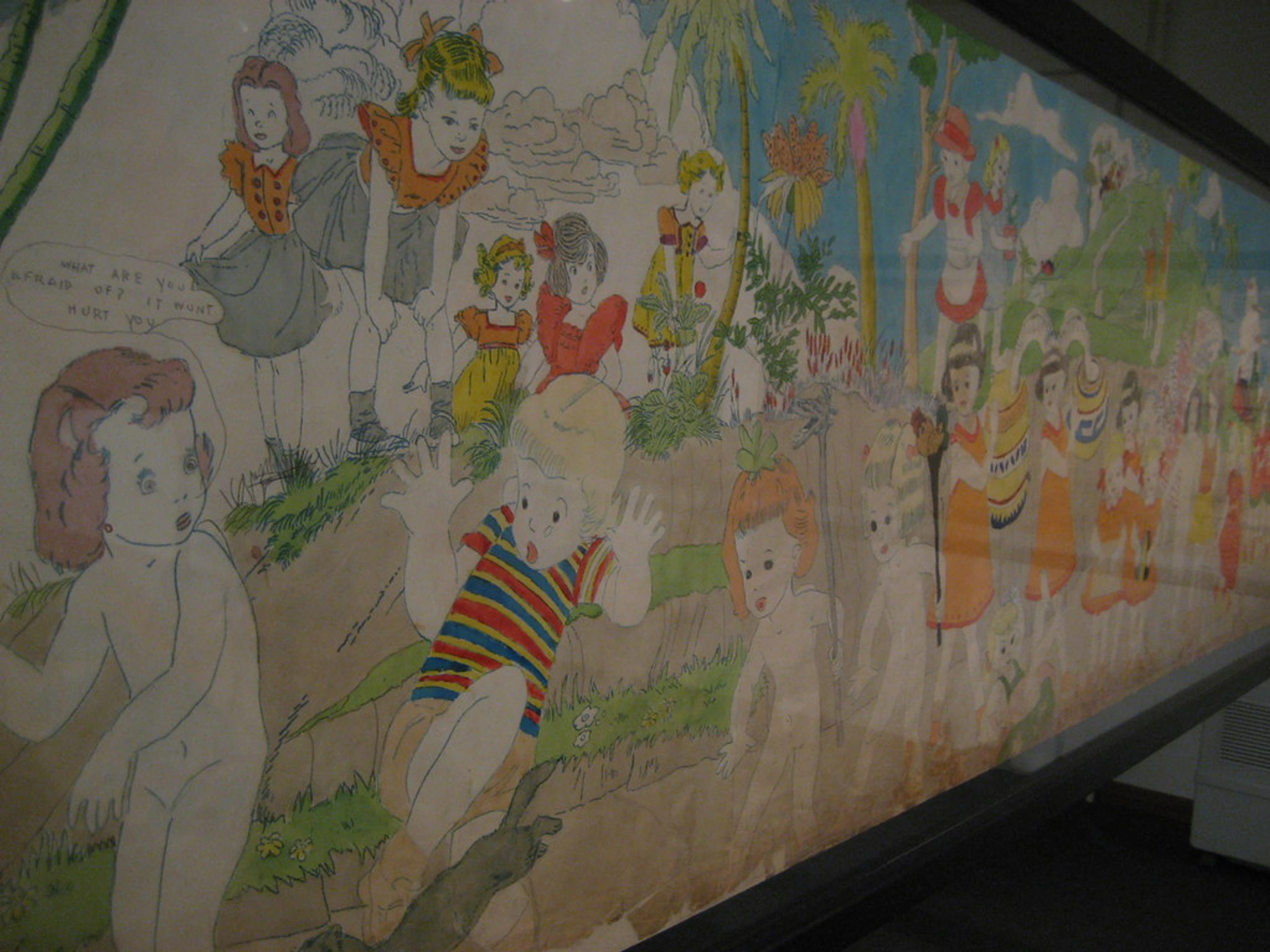
The Persistence of Memory: Dalí's Iconic Masterpiece – Meaning, Symbolism & Legacy Explored
Unlock the profound symbolism of Salvador Dalí's 'The Persistence of Memory.' This authoritative guide explores its Freudian influences, historical context, philosophical depths, pioneering techniques, and enduring legacy through a curatorial lens.
The Persistence of Memory: Dalí's Iconic Masterpiece – Meaning, Symbolism & Legacy Explored
Salvador Dalí's "The Persistence of Memory," painted in 1931, is an indelible icon of 20th-century art, instantly recognizable yet endlessly enigmatic. This relatively small oil on canvas, measuring a modest 9.5 by 13 inches (24.1 x 33 cm), has captivated and confounded viewers for decades. Its imagery of melting clocks and a desolate landscape is synonymous with Surrealism. As curators of art history, we recognize this work not merely as a painting, but as a visual manifesto, a cornerstone of modern art that invites deep exploration. This comprehensive guide aims to be the definitive resource for understanding this masterpiece, meticulously exploring its profound symbolism, intriguing historical context, pioneering artistic techniques, and enduring legacy. It unpacks the layers of meaning, inviting art enthusiasts, students, and curious minds to delve into the unique mind of Salvador Dalí and the broader currents of art history with unparalleled insight, much like how contemporary artists, such as Zen Dageraad Visser, continue to explore subjective realities and emotional landscapes through their abstract compositions.
The Genesis of a Masterpiece: Dalí's Epiphany and the Melting Moment
By 1931, Salvador Dalí was deeply immersed in the Parisian Surrealist movement, a radical artistic and intellectual current that emerged from the disillusionment following World War I and evolved from Dadaism's iconoclastic spirit. Surrealism sought to liberate the creative potential of the unconscious mind, a concept profoundly influenced by the burgeoning field of psychoanalysis. Dalí's intellectual appetite was voracious, drawing from Freudian psychoanalysis, the philosophical concepts of time, and the unsettling visions of artists like Giorgio de Chirico. He sought to materialize the irrational, to capture the very essence of the dream state with hyperrealistic precision.
Giorgio de Chirico's influence on Dalí's early surrealist landscapes is particularly noteworthy. De Chirico, a pioneer of Metaphysical painting, created desolate cityscapes, arcaded squares, and uncanny arrangements of everyday objects bathed in deep, unsettling shadows. This created a profound sense of mystery and foreboding, a 'dream logic' that directly inspired Dalí's own barren, enigmatic settings and his approach to juxtaposing the ordinary with the bizarre.
The historical milieu of the interwar period, with its profound anxieties and the rise of totalitarianism across Europe, subtly informed the sense of unease and decay that permeated much of Surrealist art, including Dalí's. This era of societal upheaval contributed to a widespread questioning of established orders and rational thought, making fertile ground for movements that explored the subconscious and the irrational, sometimes reflecting a commentary on the loss of traditional values.

It was within this rich intellectual and artistic ferment that a seemingly ordinary moment sparked one of art history's most extraordinary creations. The genesis of "The Persistence of Memory" is famously rooted in a mundane yet pivotal moment in Dalí's personal life. The artist himself recounted that the inspiration for the soft, melting clocks arose from observing a piece of Camembert cheese melting in the sun on a hot August evening after a dinner. One can almost picture him, perhaps a migraine throbbing as he described, watching the cheese slowly surrender to the heat, its once-solid form becoming pliable, almost liquid. This mundane culinary experience, observed while his wife and lifelong muse, Gala, was at the cinema, triggered profound reflections on the fluidity of time and reality. The melting cheese, with its soft, yielding form, perfectly resonated with Dalí's internal considerations on time's malleability, igniting a profound visual and conceptual association that would become the painting's hallmark.
Upon Gala's return, Dalí reportedly announced, "You'll see it and remember it for the rest of your life. It's magnificent." Within two hours, the painting was complete, born from this spontaneous epiphany, an instantaneous crystallization of profound thought, where a simple observation merged with complex subconscious reflections. It is a striking example of an artist transmuting the everyday into the extraordinary, challenging us to see the profound in the prosaic.

From this unique culinary inspiration, Dalí meticulously conjured a dreamscape brimming with potent symbols, each rendered with startling precision to challenge our perception of reality. The immediate critical and public attention garnered by "The Persistence of Memory" solidified Dalí's reputation as a groundbreaking Surrealist, and the painting's imagery quickly permeated the collective consciousness. It would become a foundational work of the movement, a visual manifesto of its core principles, presented for the first time at the Julien Levy Gallery in New York City in 1932.
But what happens when this spontaneous combustion of genius crystallizes onto canvas? The viewer is invited to delve into the symbols that make this painting so utterly unforgettable.
Decoding the Masterpiece: Unpacking Its Iconic Elements
The painting's core visual elements are each steeped in profound symbolism, meticulously rendered to form Dalí's compelling dreamscape. This section delves into the individual components that collectively make "The Persistence of Memory" an endlessly fascinating work, demonstrating Dalí's genius in making the impossible tangible.
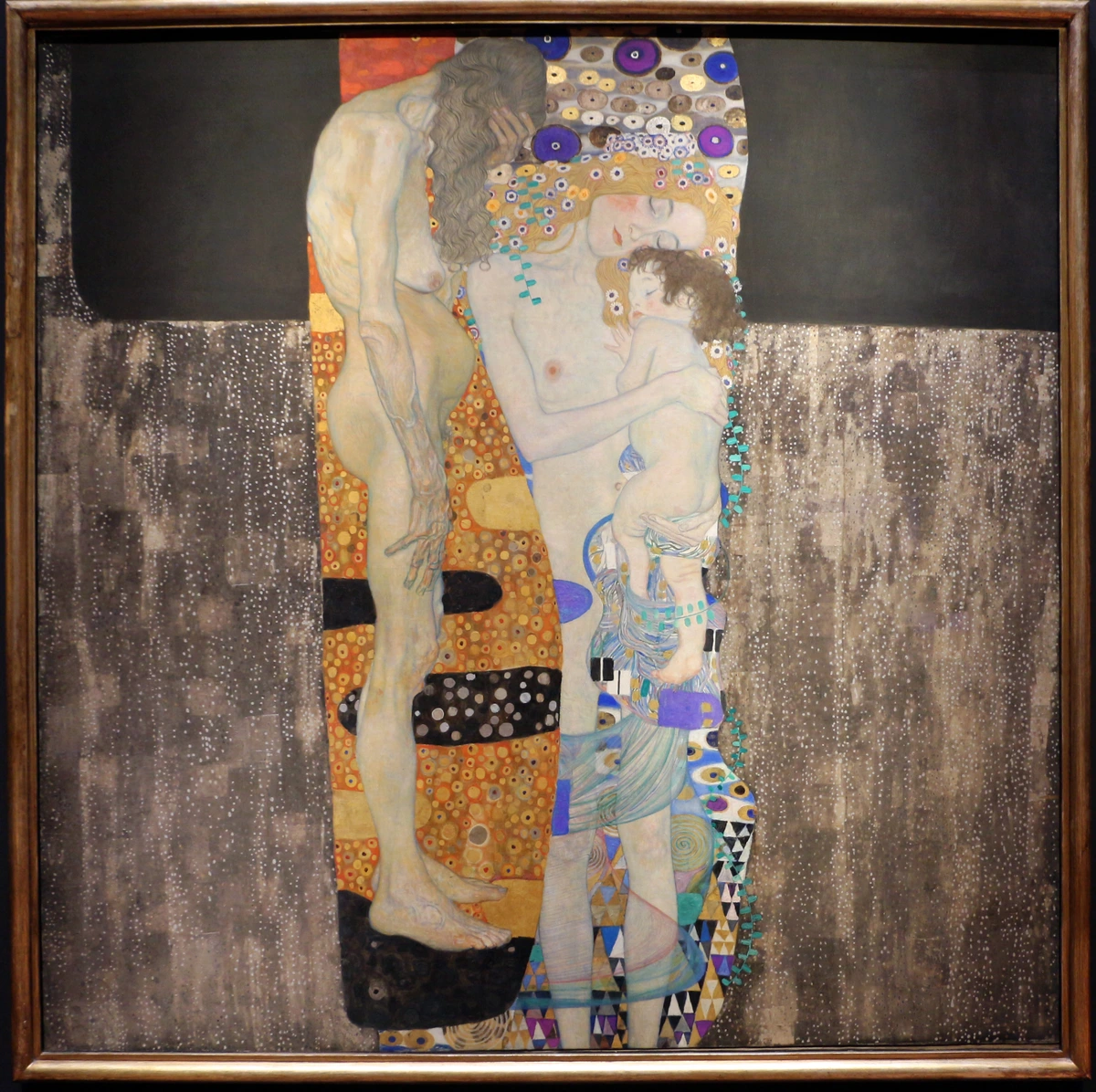
The Subjective Realm of Time: The Melting Clocks
At the heart of "The Persistence of Memory" are its most striking and debated elements: the melting clocks. Three soft, distorted pocket watches are scattered across the scene. One drapes dramatically over a dead tree branch, another clings precariously to the edge of a platform, and a third, face down, is covered in ants. This representation of time as something malleable, rather than rigid and fixed, is central to the painting's meaning.
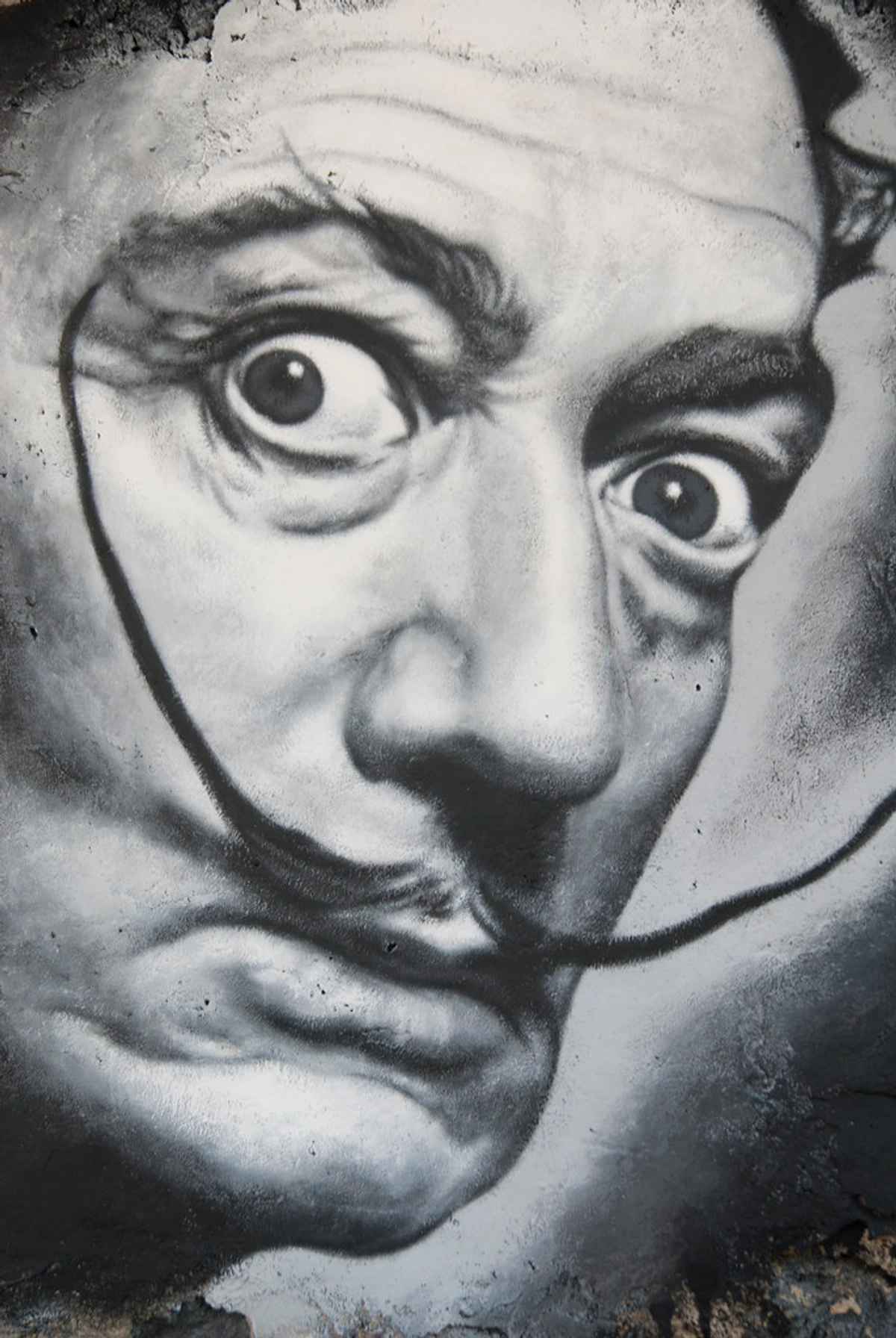
Beyond Einstein and Bergson: Time as a Personal Construct
The early 20th century was a period of profound re-evaluation of time, heavily influenced by Albert Einstein's theories of relativity, which posited that time is not absolute but relative to an observer's motion. Dalí, however, translates this scientific concept into a deeply psychological and artistic one. The soft watches suggest a dissolution of conventional reality, where time ceases to be an external, objective force and instead becomes a subjective experience, flowing and distorting with the subconscious mind. They speak to the transience of life, the decay of memory, and the unsettling idea that human perception of time is far from absolute.
Further influence can be seen in the philosophy of Henri Bergson, whose concept of duration (durée) emphasized time as a continuous, indivisible flow experienced subjectively, rather than a series of discrete, measurable moments. Imagine how a minute can feel like an hour when one is bored, or several hours can fly by when deeply engrossed in something captivating. This everyday experience perfectly encapsulates Bergson's idea, and Dalí's melting clocks are a powerful visual metaphor for this subjective, psychological time, especially within the vivid, illogical landscapes of dreams. Henri Poincaré also contributed to the philosophical discourse on time, differentiating between a conventional, measurable time and a psychological, intuitive experience of time, concepts that resonate strongly with Dalí's depiction. Dalí's deliberate choice of portable pocket watches, rather than larger wall clocks or wristwatches, emphasizes a personal, intimate, and almost archaic relationship with time. These small, manually wound devices, once kept close to the body, become vulnerable to the mind's distortions, underscoring how deeply personal and fragile the experience of time can be when freed from mechanical constraints.
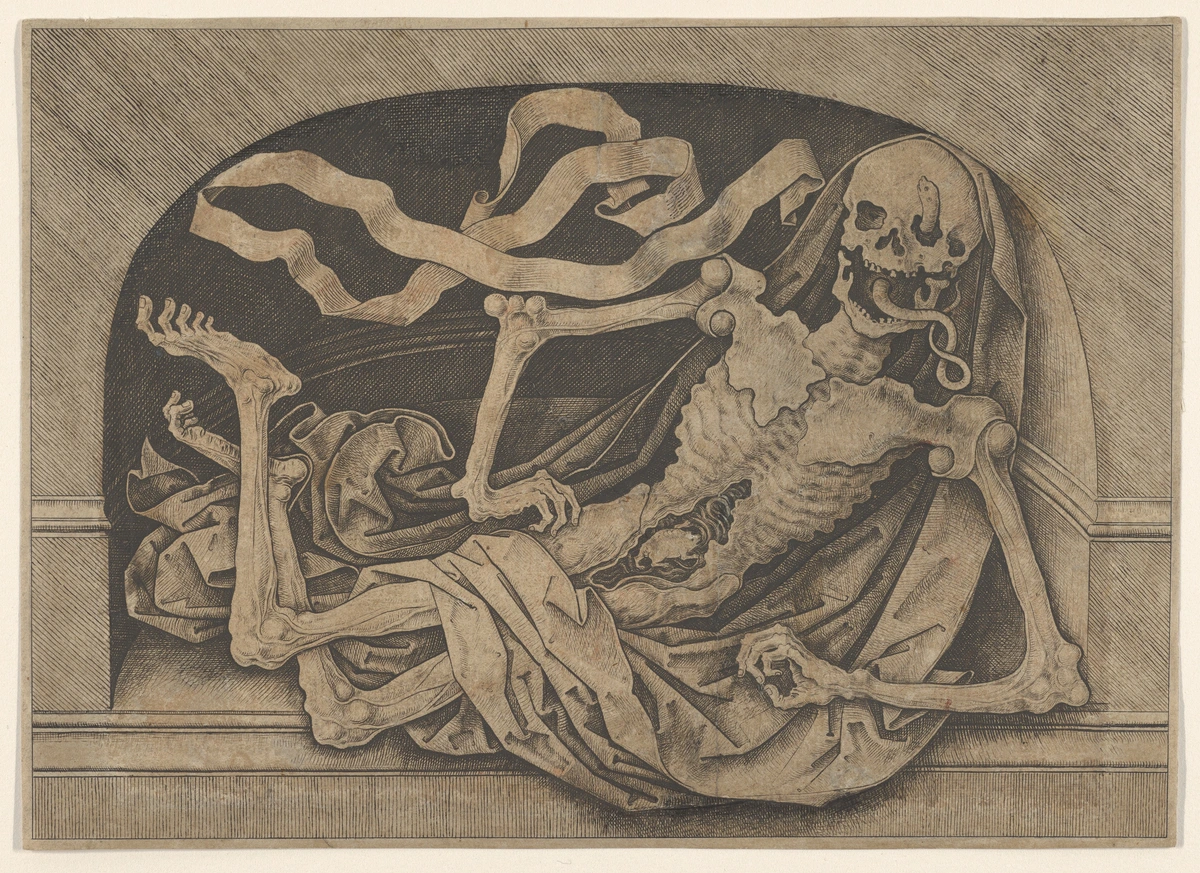
Anatomy of a Dream: Key Symbolic Elements
Dalí's dreamscape is meticulously constructed with symbols, each adding layers of meaning to the overall composition. The distinction between the fluid, subjective time of the subconscious and the rigid, objective time of the external world is a core dichotomy within the painting.
- The Softness of Time: The very 'softness' of the watches is crucial. It represents the psychological dimension of time, where it stretches and compresses based on one's emotional state or subconscious experience, particularly in dreams. Dalí often sought to depict the concrete reality of the irrational, making these impossibly soft objects intensely real on the canvas. This is Dalí's famous concept of "hand-painted dream photographs"—meticulous detail applied to fantastical visions.
- The Hard Watch and Mortality: In stark contrast to the melting forms, a single, conventional, hard pocket watch lies face down on the platform, covered in ants. This juxtaposition is vital; it highlights the conflict between objective, measurable time and subjective, perceived time. The hard watch, perhaps representing objective, mechanical, or societal time, is being consumed by decay. Its metallic form is vulnerable to the very forces of nature it is meant to measure. Its face-down position can also symbolize a deliberate turning away from or rejection of objective, quantifiable time. This suggests the ultimate vulnerability of all things, even precise instruments, to the relentless march of mortality, a classic memento mori element. It represents the inescapable, rigid fate against the fluidity of subjective experience, being devoured by the forces of decomposition.
- The Orange Clock: Urgency and Fading Vitality: The orange clock, draped over the platform, appears almost foreshortened, suggesting an impending sense of urgency or doom, a sunset of conventional time. Its warm, fading color draws the eye, hinting at a fading vitality or a moment of transition. Its color suggests a sense of urgency, perhaps like a sunset signaling the end of a day or the fading of pleasure, connecting to Dalí's own anxieties about transience.
- Ants: Decay and Primal Fear: For Dalí, ants were not merely insects; they were powerful, deeply unsettling symbols of decay, death, and an intense, almost primal, fear of putrefaction and mortality. His childhood phobia of these creatures translated into a recurring motif in his art, underscoring the macabre and unsettling undercurrents of his dreamscapes. Their presence, particularly on the hard, intact pocket watch, vividly emphasizes the theme of inevitable decay consuming even the most rigid structures of time and existence. Dalí also harbored a profound fear of locusts and grasshoppers, associating them with anxiety and disintegration, elements that subtly inform the overall mood of primal dread and vulnerability. The visual characteristics of swarming, segmented insects also contribute to this unsettling atmosphere across his broader body of work.
- Fly: Ephemeral Existence: A single fly rests on the orange clock. Similar to ants, the fly is traditionally associated with decomposition and the fleeting nature of existence, further emphasizing the theme of mortality and the relentless passage of time, a silent witness to decay.
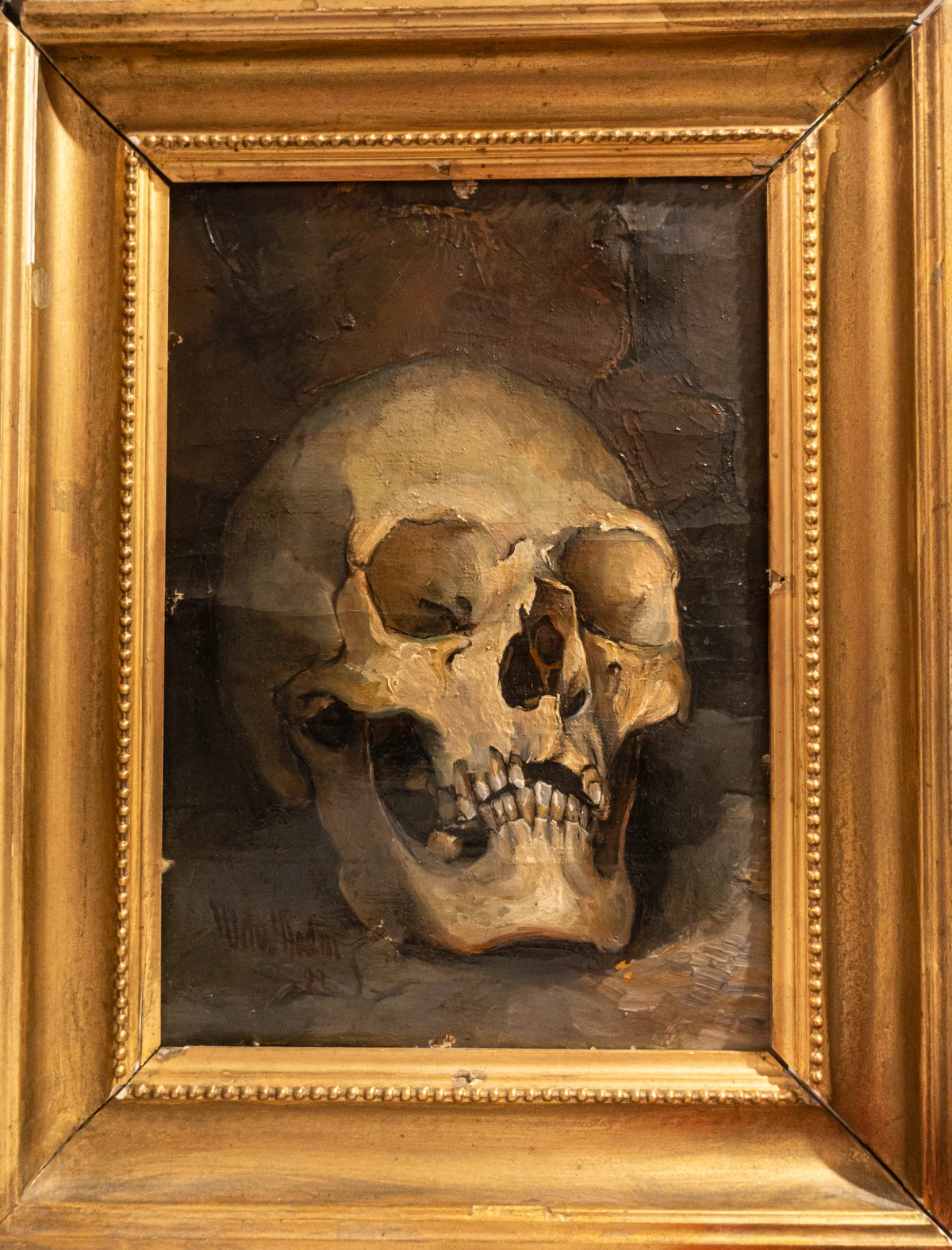
The Canvas as a Dreamscape: Dalí's Personal Landscape and Enigmatic Forms
The setting for Dalí's time-bending drama is a stark, almost barren landscape, instantly recognizable to those familiar with his life. This scene is often identified as a stylized representation of Port Lligat, a small fishing village in Catalonia, Spain, where Dalí lived and drew much of his inspiration. This rugged, isolated coastline, with its intense, almost blinding light, arid mountains, and crystal-clear waters, was not merely a backdrop; it was a profound source of personal identity and artistic fuel for Dalí. The distinctive geological formations of Cap de Creus, with their wind-sculpted rocks and dramatic cliffs, profoundly influenced his rendering of the desolate yet sublime environment, often appearing as biomorphic shapes within his canvases. The vast, empty space evokes a dreamlike quality, serving as a stage for the subconscious mind to project its deepest anxieties and desires. This sense of infinite space accentuates the surreal elements within it, making the impossible seem both distant and intimately real. The painting's small scale (9.5 by 13 inches) was a deliberate choice to create an intimate, almost claustrophobic dreamscape, forcing the viewer into a close, personal encounter with the irrational. This jewel-like quality intensifies the focus on the impossible textures and unsettling precision, contrasting sharply with the grandeur often associated with masterpieces and inviting a deeply personal engagement, much like how a small, vibrant abstract work can draw a viewer into its complex inner world.
Prominently placed in the center of the painting is a distorted, amorphous form, widely interpreted as a self-portrait of Dalí himself, depicted in a state of deep sleep or unconsciousness. Often referred to as a "monster" or creature due to its unsettling appearance, this figure, with its long eyelashes and fleshy texture, suggests the defenselessness of the sleeping mind, where dreams and anxieties manifest freely, stripped of rational defense. While the self-portrait interpretation is dominant, some scholars suggest it could also represent a universal, vulnerable human form, a primordial being, or even a symbolic creature born from the subconscious, representing the abstract artistic process itself, or even a state of metamorphosis or transition, reflecting Dalí's interest in the fluidity of identity.
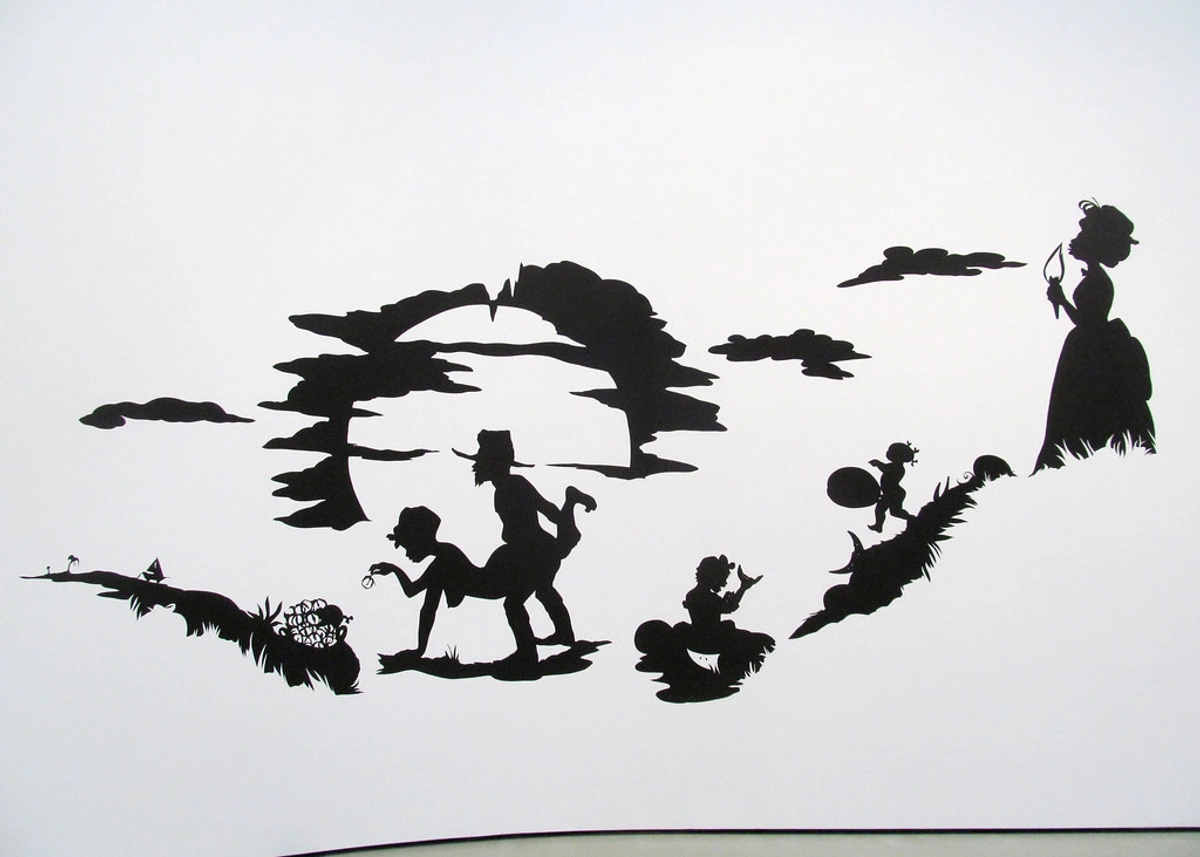
Another significant detail is the dead olive tree, from which one of the soft watches hangs. The olive tree, typically a symbol of peace, longevity, and ancient wisdom, here appears gnarled, lifeless, and devoid of leaves. This stark depiction suggests a decline, or perhaps the death of traditional concepts of time, vitality, and even spiritual peace within this surreal realm. For Dalí, and within Catalan culture, the olive tree holds deep historical and agricultural significance. Its lifeless state in the painting amplifies a sense of desolation and the impermanence of even the most enduring symbols when confronted with the forces of decay and the subconscious, implying a world where established orders have dissolved or become perverted.
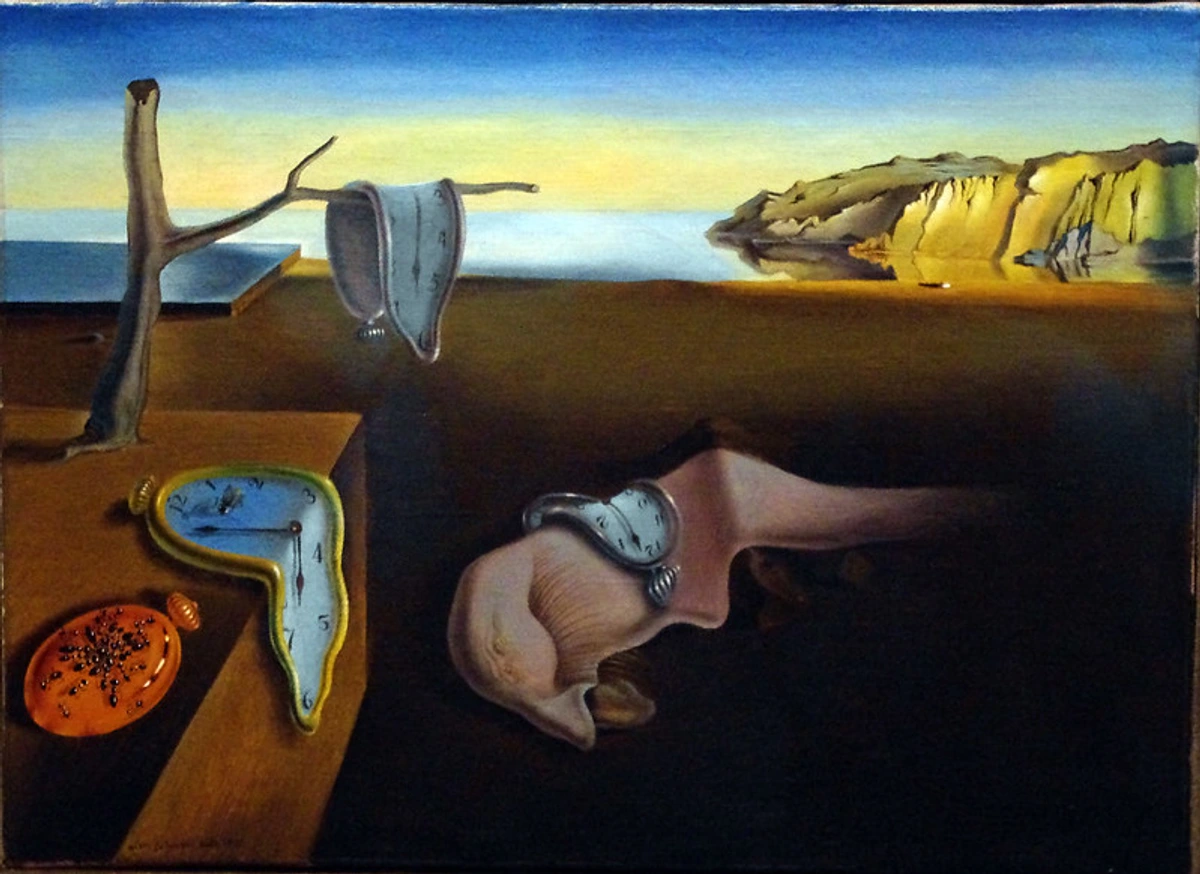
To visually consolidate the profound layers of meaning within "The Persistence of Memory," a breakdown of its key symbolic elements reveals Dalí's masterful artistic and intellectual allusions:
Symbolic Element | Curatorial Interpretation | Art Historical Context |
|---|---|---|
| Melting Clocks | The fluidity and relativity of time, mirroring the subjective, psychological experience within the dream state or subconscious. It questions linear progression and the rigidity of measurable time. | Influenced by Einstein's theories of relativity, Bergson's concept of 'duration' (subjective, continuous time), and Poincaré's ideas on intuitive time. |
| Hard Pocket Watch | Represents objective, measurable time, contrasted with the fluid subjective experience. Its prone, ant-covered state suggests the vulnerability of mechanical time to decay and mortality, a rigid fate being consumed by natural forces. Its face-down position also implies a deliberate rejection of objective time. | A classic memento mori element, symbolizing the inevitability of death and the passage of physical time. |
| Orange Clock | A sense of urgency, impending doom, or the brevity of existence. Its warm, fading color suggests a fading vitality or the end of a conventional time cycle, potentially linked to personal anxieties about the ephemeral nature of pleasure. | Connects to themes of transience, often seen in sunset motifs or fading colors in allegorical works. |
| Desolate Landscape | Evokes emptiness, isolation, and serves as a boundless stage for irrational visions of the subconscious. It is a stylized rendering of Dalí's beloved Catalan homeland, Port Lligat, reflecting its stark beauty and the unique geological formations of Cap de Creus. | Common in Surrealist dreamscapes; personal landscapes imbued with psychological meaning and influenced by Italian Metaphysical painting. |
| Central Figure | A distorted, sleeping self-portrait of Dalí, representing the artist's vulnerable, unconscious self. It symbolizes the defenselessness of the mind during sleep, where desires and fears manifest freely, or a state of metamorphosis. Other interpretations include a primordial form or abstract artistic creation. | Reflects Freudian psychoanalysis, where the artist's inner world is projected onto the canvas, and a universal vulnerability. |
| Ants | A powerful symbol of decay, death, and putrefaction, stemming from Dalí's deep-seated phobias. Their presence underscores mortality and the relentless process of decomposition, consuming even rigid structures. | A recurring Surrealist motif, often used to evoke primal fears or the grotesque aspects of life, rooted in personal phobias. |
| Fly | Signifies decomposition and the ephemeral nature of life, further emphasizing mortality and the relentless passage of time, a silent witness to decay. | Another traditional symbol of decay and transience, often paired with ants or other insects in vanitas paintings. |
| Olive Tree | A gnarled, lifeless tree suggesting the decline of traditional beliefs, the death of vitality within the dream world, or the impermanence of even enduring symbols like peace and wisdom; a perversion of established order. | Traditionally a symbol of peace and longevity, its dead state offers a powerful contrast, emphasizing loss or decay. |
| Distant Sea/Cliffs | Represents the vastness and infinity of both the natural world and the subconscious. It acts as a boundary between conscious reality and the dream state, hinting at unplumbed depths of the mind and geological time. | Evokes the limitless expanse of the unconscious, a common theme in Romantic and Symbolist landscapes, adopted by Surrealism. |
Dalí's Intellectual Tapestry: Freudian Insights, Paranoiac-Critical Method, and Broader Influences
Salvador Dalí's artistic vision was deeply intertwined with his personal life, his intellectual curiosities, and his profound psychological landscape. His relationship with his wife, Gala Dalí, was a colossal influence, extending far beyond that of a mere muse or manager. Gala became his emotional anchor, his intellectual confidante, and a central figure not only in many of his works but also in his very process, often providing the stability and challenge necessary for his artistic breakthroughs. Her presence during the famed Camembert epiphany, for instance, underscores her direct involvement in his creative moments.
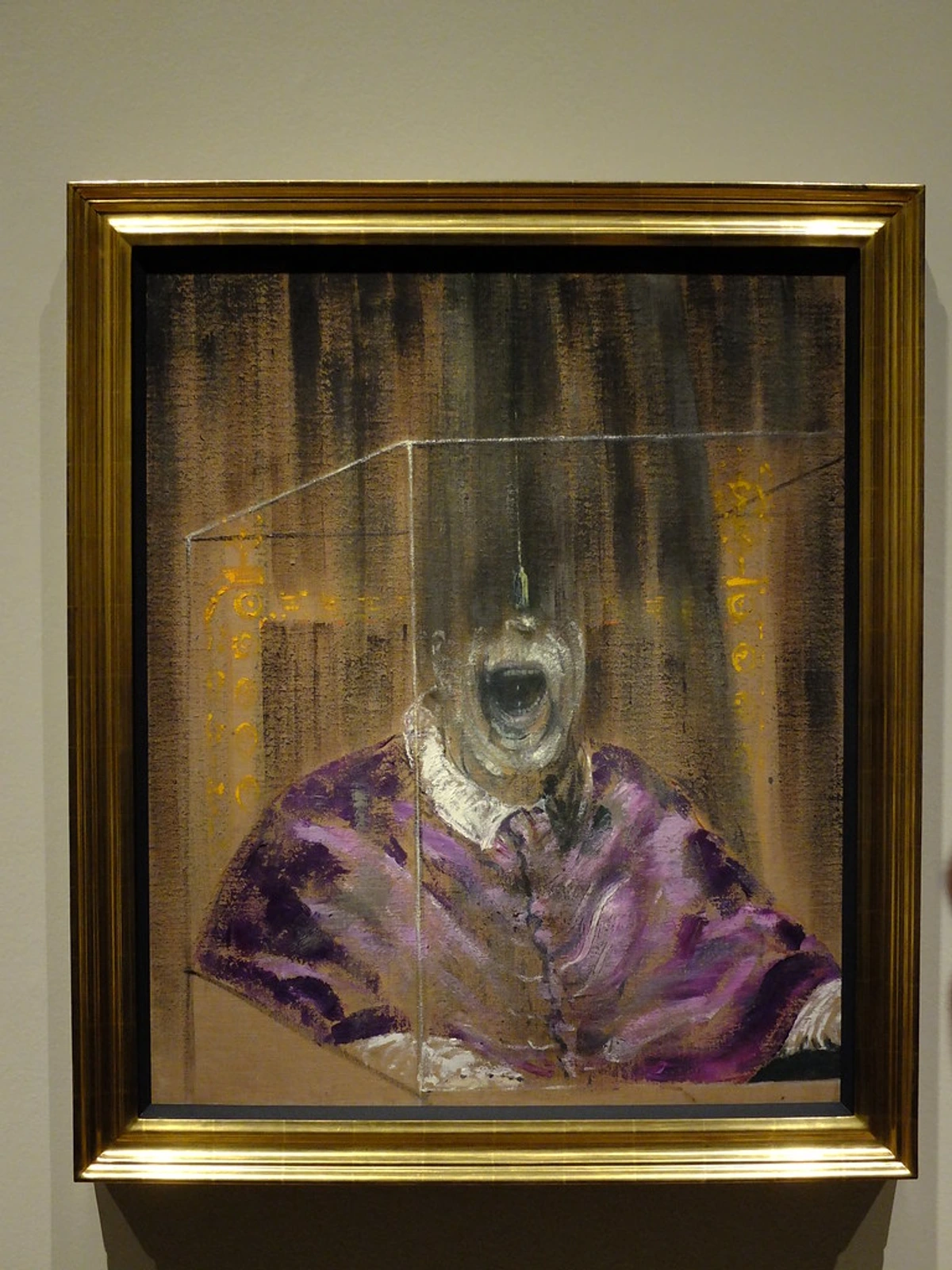
The Paranoiac-Critical Method: Materializing the Intangible
"The Persistence of Memory" is a quintessential example of Surrealism, an art movement that sought to liberate the creative potential of the unconscious mind, free from the constraints of rational thought. Dalí's unique approach to achieving this was his self-invented Paranoiac-Critical Method. This technique involved inducing a self-proclaimed hallucinatory or paranoid state to systematically interpret and render subconscious images. For example, in the creation of "The Persistence of Memory," Dalí might have intently focused on the melting Camembert, allowing his mind to make seemingly illogical, dream-like associations—seeing the cheese's soft, yielding texture transmute into drooping pocket watches. He would then meticulously render this internal vision with hyperrealistic precision on canvas, aiming to make the "concrete irrationality" of his dreams appear as real and meticulous as possible. This was Dalí's way of making the unseen visible, of capturing the elusive logic of dreams with unsettling clarity. His paintings, often described as "hand-painted dream photographs," are a testament to his desire to materialize the intangible visions of the subconscious with unsettling precision.
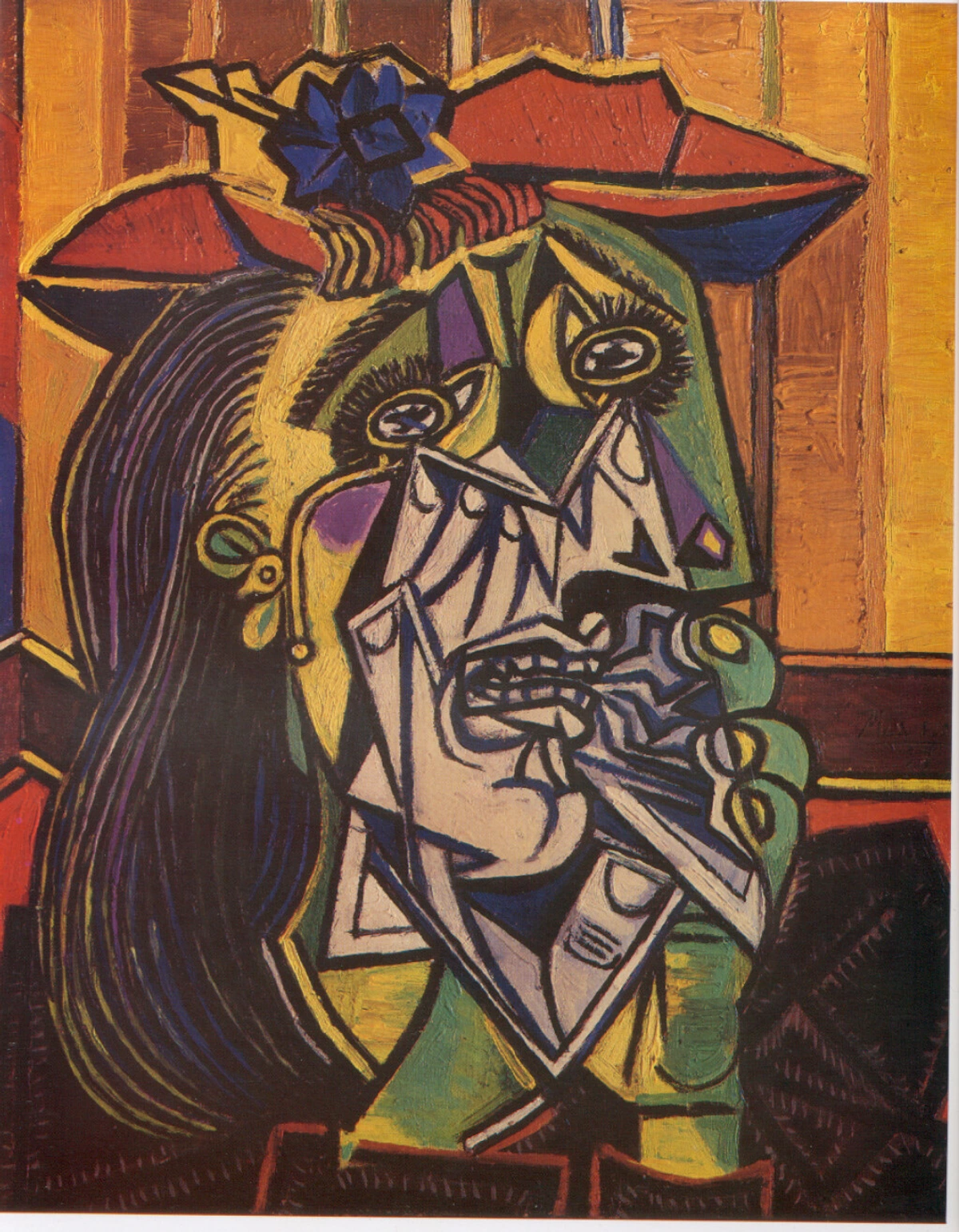
This method allowed Dalí to tap into universal anxieties and desires, contributing to the enduring legacy of Surrealism as a movement that challenged perception itself, much like the revolutionary spirit found in the art of Joan Miró or the disruptive power of Picasso. Other Surrealists like René Magritte, with his conceptual playfulness and exploration of the mystery in everyday objects, and Max Ernst, with his innovative frottage and decalcomania techniques, also sought to manifest the unseen worlds of the mind, often with a mystical or abstract twist.
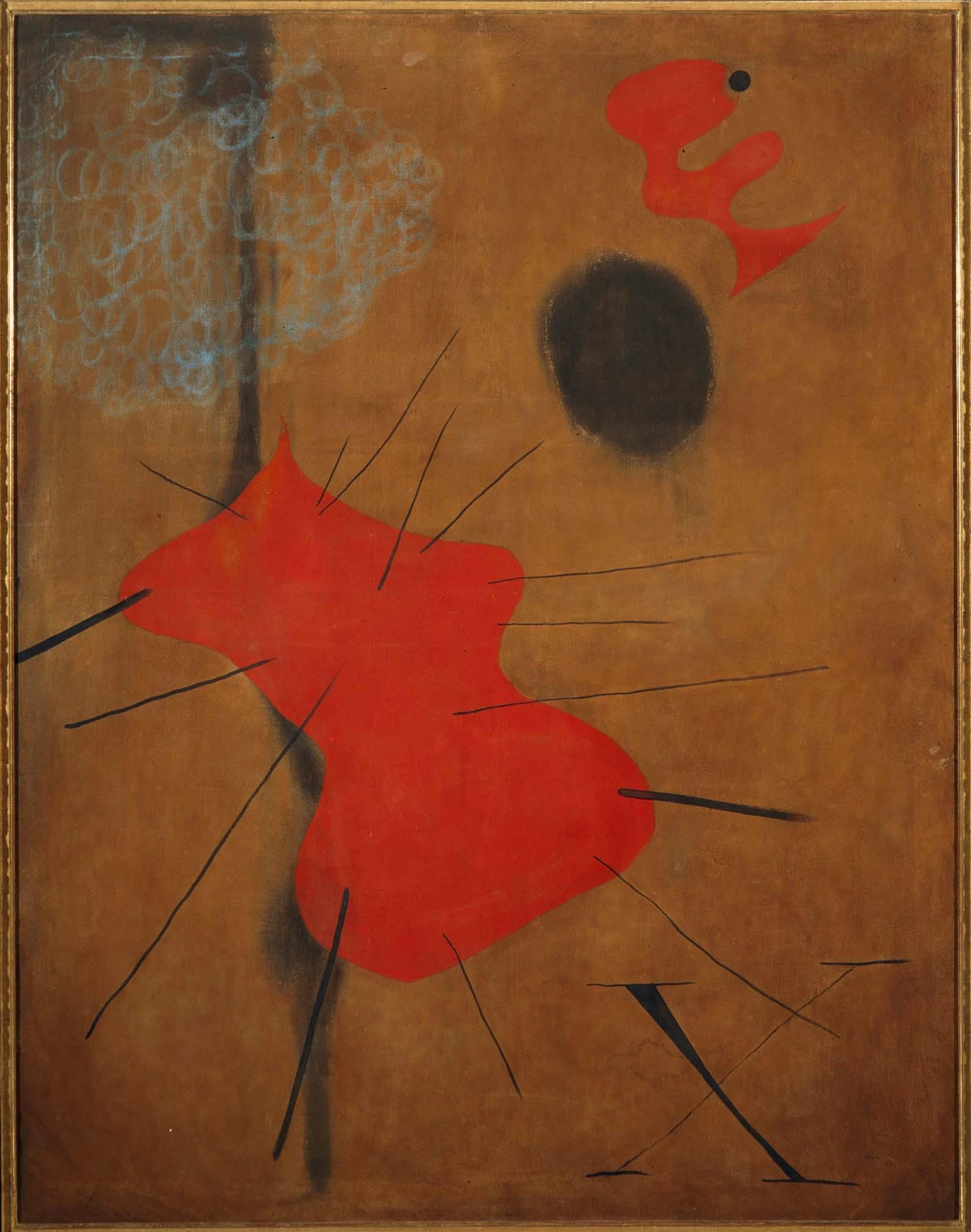
Key Intellectual Influences
- Freudian Psychology and the Subconscious: Dalí was a voracious reader of Sigmund Freud and deeply fascinated by psychoanalysis. He believed that art should explore the hidden desires, fears, and anxieties residing in the subconscious mind. "The Persistence of Memory" is a direct visual representation of Freudian dream theory, where familiar objects are dislocated and distorted, revealing deeper psychological truths. The melting clocks, the amorphous self-portrait, and the desolate landscape are all manifestations of this Freudian exploration, inviting viewers to ponder the repressed desires and anxieties that shape human experience. Freud's concepts of the id, ego, and superego provide a lens through which to view Dalí's work: the raw, instinctual desires of the id break through the rational controls of the ego and the moral constraints of the superego, manifesting in the dream-like, often disturbing, imagery. The painting offers a window into the dream state, where the barriers between conscious and unconscious thought dissolve, and symbolic language reigns supreme. Artists like Frida Kahlo also explored intensely personal and psychological themes in their work, often drawing parallels to Surrealist concerns by externalizing inner turmoil.
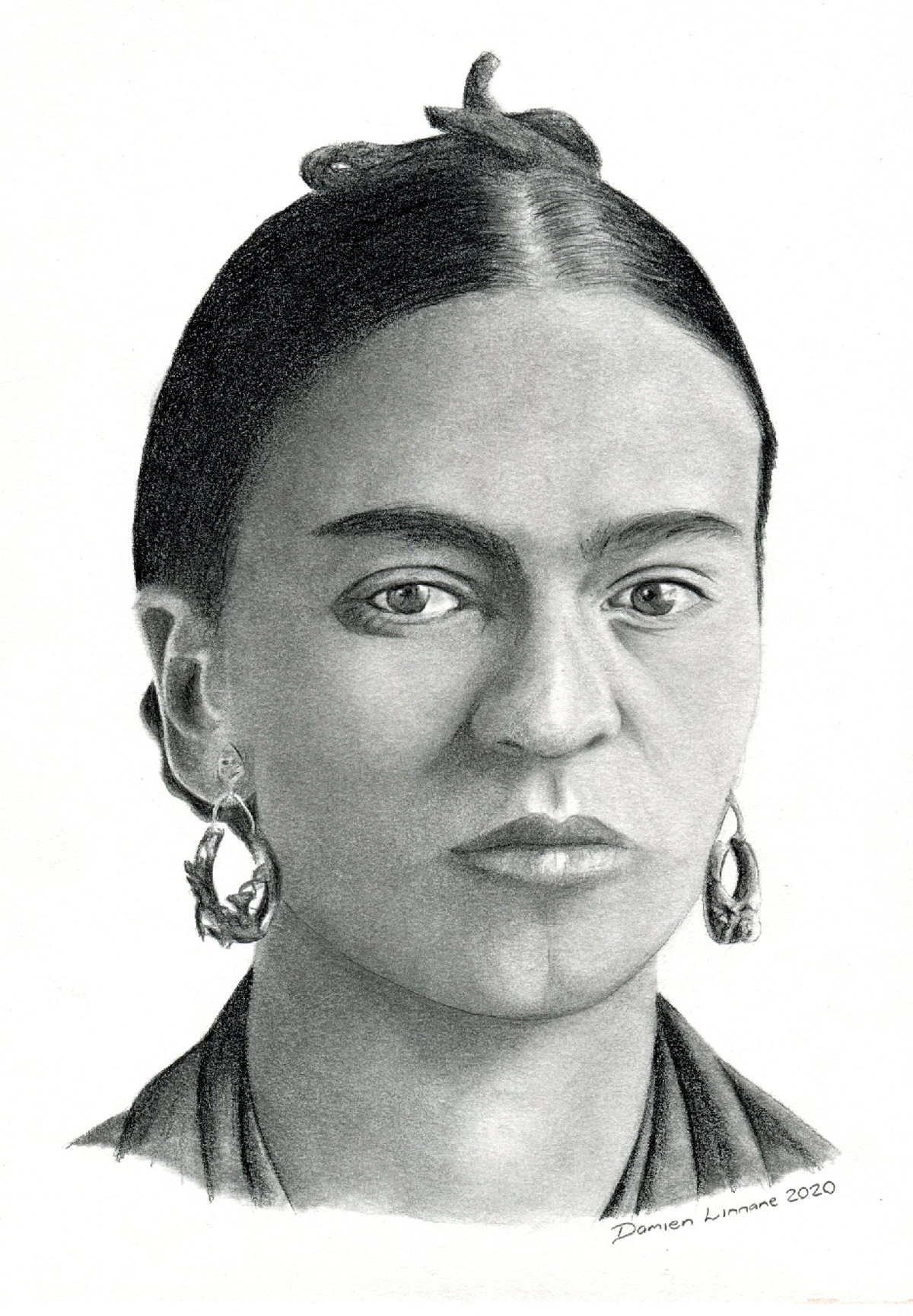
- Other Intellectual and Artistic Influences: Beyond Freud, Dalí's intellectual curiosity drew from a wider tapestry of influences, reflecting the avant-garde spirit of his time. He was profoundly influenced by 19th-century French writers such as Comte de Lautréamont, whose prose poem Les Chants de Maldoror famously featured "the chance encounter of a sewing machine and an umbrella on an operating table." This striking juxtaposition of incongruous elements was a quintessential Surrealist device, directly adopted by Dalí to shock and provoke, creating new, often disturbing, realities from disparate parts. Literary figures like Gérard de Nerval and Charles Baudelaire, with their explorations of dreams, the uncanny, and the hidden realities beneath the surface of everyday life, provided important literary precursors to the Surrealist sensibility that Dalí embodied. Artistically, Dalí admired the precise, unsettling landscapes of the Italian Metaphysical painter Giorgio de Chirico, whose desolate cityscapes, arcaded squares, and uncanny arrangements of objects clearly prefigured Surrealist dreamscapes and their sense of profound mystery, directly influencing Dalí's barren, enigmatic settings.
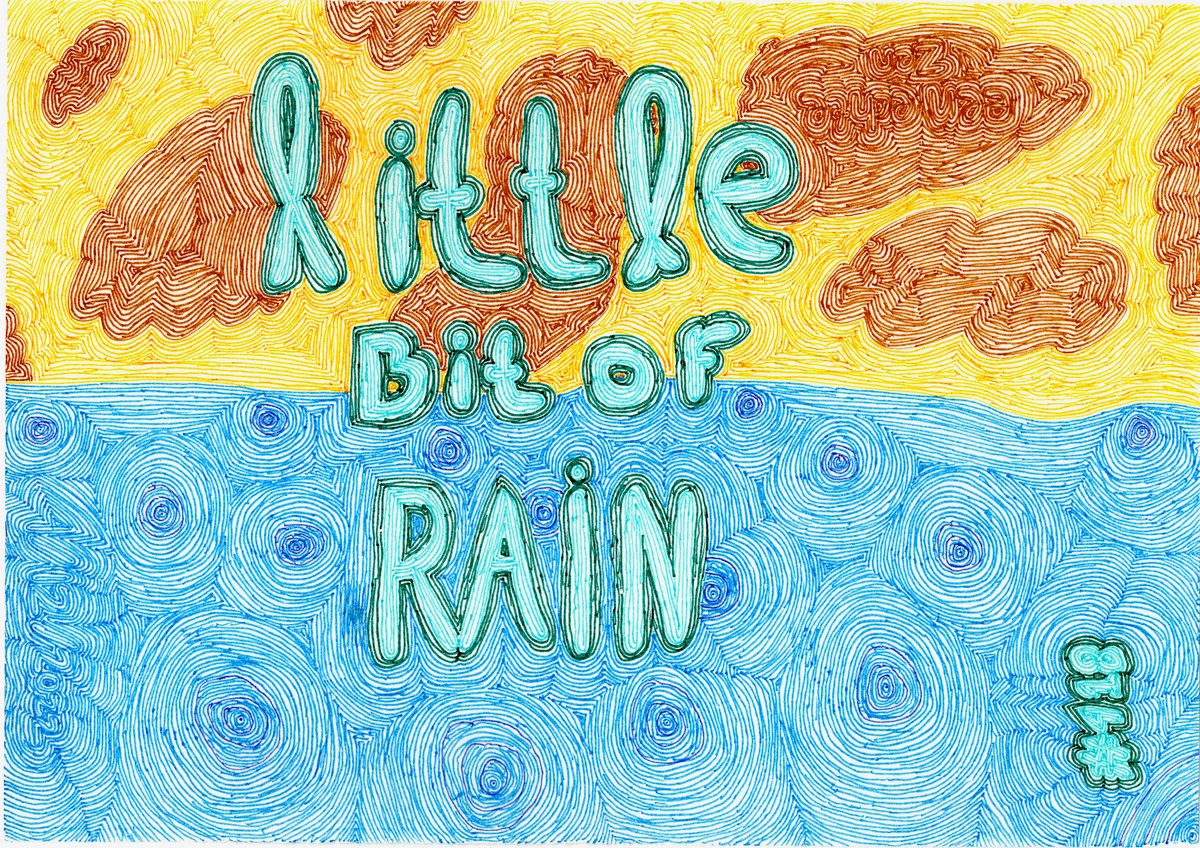
Dalí also engaged with emerging existential philosophical themes, questioning the nature of reality and subjective experience. By distorting time, he invited contemplation on how human consciousness shapes perception, challenging viewers to consider the fluidity of truth and the transient nature of all things. Furthermore, his fascination extended to scientific concepts such as quantum mechanics and optical illusions, which subtly informed his exploration of distorted reality and the manipulation of perspective, evident in the shifting perceptions within "The Persistence of Memory." His Catalan heritage, particularly the rugged landscapes and intense light of Port Lligat and Cap de Creus, was not merely a backdrop but a deep well of personal identity and artistic inspiration, influencing the stark, ethereal quality of his skies and the biomorphic geological forms in his paintings.
Dalí's Personal Phobias and Recurring Symbols
Beyond the ants, Dalí harbored a profound fear of locusts, which he associated with putrefaction, anxiety, and a sense of impending doom. This phobia, along with others like his aversion to crickets and grasshoppers, often informed his darker symbolic choices, connecting to themes of disintegration and decay that would become even more pronounced in his later works. The presence of the ants in "The Persistence of Memory" is a direct manifestation of this deep-seated revulsion, transforming a mundane insect into a powerful emblem of rot and mortality within his dreamscapes.
His artistic vocabulary also included recurring symbols like eggs (representing rebirth, hope, and often fragility), crutches (symbolizing support, but also fragility and the inevitability of death), and distorted bread (suggesting sustenance, but often in forms reflecting the fragility of life or the perversion of natural order). While not all prominently featured in "The Persistence of Memory," these motifs collectively illuminate the anxieties and fascinations that shaped Dalí's worldview and his art. Dalí's unique vision, born from such intensely personal phobias and symbolic interpretations, sometimes echoes the raw, unfiltered personal expression found in outsider art, though his meticulous technique firmly places him within the mainstream avant-garde.
To summarize the broad range of intellectual and artistic currents that shaped Dalí's vision for "The Persistence of Memory":
Influence Category | Key Figures/Concepts | Impact on "The Persistence of Memory" |
|---|---|---|
| Psychoanalysis | Sigmund Freud (Id, Ego, Superego, Dream Theory, The Uncanny) | Visual manifestation of subconscious desires, fears, and repressed anxieties; distortion of reality to reveal inner truths. The central figure as a vulnerable psyche. |
| Philosophy of Time | Albert Einstein (Relativity), Henri Bergson (Duration), Henri Poincaré (Intuitive Time) | Depiction of time as subjective, fluid, and malleable, challenging linear progression and objective measurement. Melting clocks are the primary visual metaphor. |
| Literary Precursors | Comte de Lautréamont (Juxtaposition), Gérard de Nerval, Charles Baudelaire (Dreams, Uncanny) | Adoption of incongruous elements and unsettling juxtapositions; exploration of hidden psychological realms and dream states. |
| Artistic Movements | Italian Metaphysical Painting (Giorgio de Chirico), Surrealism (Yves Tanguy, René Magritte, Max Ernst) | Influenced the desolate, enigmatic landscapes and uncanny arrangements of objects; situated the work firmly within the Surrealist exploration of the unconscious. |
| Scientific Concepts | Quantum Mechanics, Optical Illusions | Subtle informing of distorted realities and manipulation of perspective, hinting at a world where objective reality is fluid and observed phenomena are relative. |
| Personal Mythology | Catalan Landscape (Port Lligat, Cap de Creus), Personal Phobias (Ants, Locusts, Crickets) | The specific, stark setting becomes a canvas for psychological projection; phobias are transformed into potent symbols of decay and mortality, rooted in primal fears. |
Materiality and Artistic Technique: Crafting the Surreal
Despite its monumental impact, "The Persistence of Memory" is a remarkably intimate painting, measuring only 9.5 by 13 inches (24.1 cm × 33 cm). This small scale was a deliberate choice, inviting viewers to lean in, to closely examine the meticulous details that bring Dalí's irrational world to life. This jewel-like quality enhances the dreamlike experience, drawing the viewer into a personal, almost secret, psychological space. Such a size intensifies the focus on the impossible textures and unsettling precision, contrasting sharply with the grandeur often associated with masterpieces. It forces a concentrated engagement, allowing the viewer to absorb every meticulous brushstroke and conceptual paradox, much like focusing on a small, intensely detailed abstract composition where every nuance matters.
Dalí's mastery lay in his meticulous artistic technique, famously employing a hyperrealist style, rendering the impossible with painstaking detail and academic precision. He achieved this through a smooth, almost invisible brushwork, precise layering of oil paints, and meticulous attention to light and shadow, creating a finish so polished it almost resembles a photograph. His command of chiaroscuro—the dramatic use of light and shadow to create illusion of volume and depth—creates a deep sense of space and unsettling atmosphere, enhancing the dreamlike quality of the canvas. Dalí's use of traditional oil painting techniques, often involving careful preparation of his canvases and specific pigments known for their durability and luminosity, further cements his reputation for meticulous craftsmanship and his ability to create "hand-painted dream photographs."
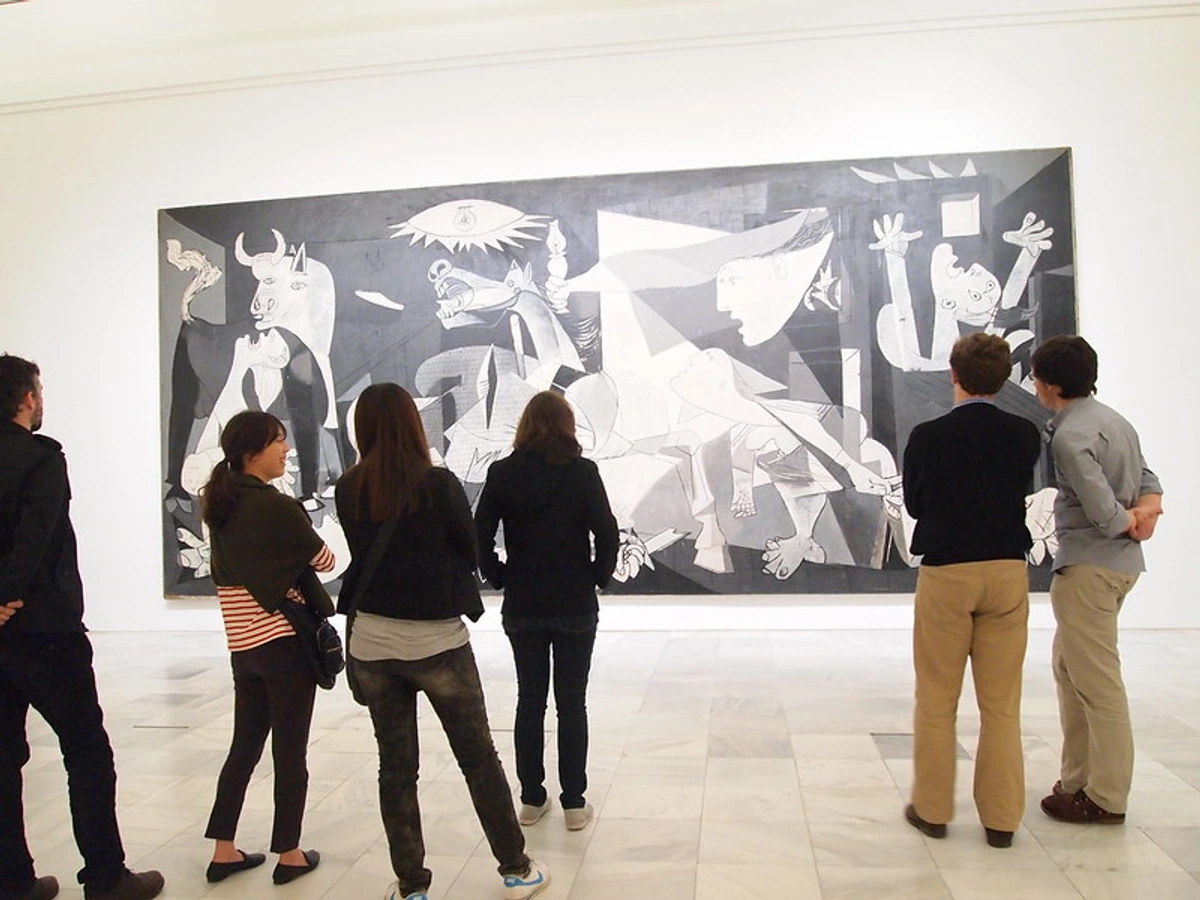
Upon its initial exhibition in 1932 at the Julien Levy Gallery in New York City, "The Persistence of Memory" immediately garnered significant critical attention. Early reviews often expressed bewilderment at its bizarre imagery but rarely denied its striking originality and profound psychological depth. Critics debated its meaning, some seeing it as a playful absurdity, others as a deep commentary on the human psyche. The debate surrounding its interpretation in its early years further solidified its status as a significant and thought-provoking work. Its rapid acquisition by the Museum of Modern Art (MoMA) in New York City in 1934, just three years after its creation, speaks volumes about its immediate recognition as a groundbreaking work that redefined modern art. It has remained a central and highly celebrated exhibit there ever since. Conservation efforts ensure the preservation of its delicate oil on canvas surface, allowing generations to engage with its enduring mystery.

Evolution and Enduring Legacy: From Memory to Disintegration
Dalí revisited the themes of "The Persistence of Memory" in later works, most notably in "The Disintegration of the Persistence of Memory" (1954). This later painting offers a reinterpretation of the original, with the familiar elements (the melting clocks, the landscape, the creature) fragmented and dispersed into atomic particles, reflecting Dalí's growing fascination with nuclear physics and the atomic age. This evolution showcases how an artist's vision can adapt and deepen over time, engaging with new scientific paradigms while revisiting foundational psychological themes. Dalí's engagement with concepts like quantum mechanics—the study of matter and energy at the most fundamental level—and the breaking down of matter directly informed this visual transformation. He was deeply affected by the atomic bombings of Hiroshima and Nagasaki, seeing in nuclear fission a metaphor for the disintegration of reality itself. He studied scientific texts and engaged with scientists, attempting to integrate these groundbreaking concepts into his surrealist vocabulary, pushing his art into a new, scientifically charged dimension.
Popular Culture Impact
The striking imagery of "The Persistence of Memory" has seeped deep into popular culture, inspiring countless homages, parodies, advertisements, and even memes. Its melting clocks have become an instantly recognizable shorthand for Surrealism, the passage of time, or simply a quirky, mind-bending visual. From animated films and television shows (such as the iconic episode of SpongeBob SquarePants where a melting clock appears) to music videos, album art, commercial campaigns, and countless artistic reinterpretations across various media, the painting's motifs are ubiquitous. This widespread recognition is a testament to its profound and lasting impact on the collective visual language, paving the way for Dalí's influence on subsequent art movements, subtly impacting everything from Pop Art's embrace of everyday objects to contemporary explorations of perception. Such pervasive cultural impact highlights the painting's universal resonance, demonstrating how an artwork can transcend its original context to become a shared cultural touchstone, much like the abstract visual language of contemporary artists can evoke universal emotions and experiences.
Comparing Two Perspectives on Time
Aspect | Original Work: "The Persistence of Memory" (1931) | Later Interpretation: "The Disintegration of the Persistence of Memory" (1954) | Artistic Intent / Philosophical Shift | Emotional Impact / Viewer Experience |
|---|---|---|---|---|
| Core Theme | Subjectivity & fluidity of time, subconscious exploration, memory decay. | Atomic age, nuclear physics, quantum mechanics, disintegration of matter and concepts, cosmic dread. | Shifting from psychological exploration of time to a scientific, post-nuclear-age contemplation of material and conceptual breakdown. | Evokes a sense of unsettling dream logic, quiet anxiety about personal time, and the fragility of memory. |
| Visual Style | Hyperrealism, dreamlike, tangible irrationality, meticulously rendered "dream photographs." | Fragmented, deconstructed, atomic particles, geometric shapes, reflecting a scientific lens and the breaking of conventional forms. | Transitioning from meticulous dream photography to a more scientific, deconstructed approach to represent cosmic forces and existential anxieties. | Creates a feeling of cosmic dread, intellectual fascination with universal breakdown, and a more abstract, less personally unsettling experience. |
| Central Figure | Amorphous, sleeping self-portrait, vulnerable, representing unconsciousness and the defenseless mind. | Fragmented, atomized, almost crystalline, less organic, representing a scientific perspective on consciousness and the breakdown of identity. | Evolving from a vulnerable, unconscious self to a more scientifically fragmented representation of identity within an atomic universe. | The original evokes empathy for the vulnerable psyche; the later work prompts intellectual reflection on the dissolution of self. |
| Landscape | Stark, desolate Port Lligat, a boundless stage for dreams and psychological projection. | Similar landscape, but broken into geometric blocks, suggesting atomic structure and instability, the very breakdown of reality. | Moving from a psychological dream stage to a visually disintegrated landscape reflecting the instability and uncertainty of the atomic age. | The initial landscape feels like a personal, internalized void; the later one suggests a universal, scientific cataclysm. |
| Clocks | Soft, melting, draped over objects, symbolizing subjective, malleable time and its fluid passage. | Dispersed into particles, often floating in space, emphasizing the breakdown of time itself into its constituent elements or an abstract quantum state. | Progressing from a symbolic representation of time's malleability to a literal breakdown of the concept of time itself into its constituent parts, reflecting scientific theories. | The melting clocks convey a gentle, unsettling distortion; the fragmented clocks evoke a sharper, more intellectual sense of time's ultimate dissolution. |
| Overall Mood | Ethereal, unsettling, meditative, psychological, deeply introspective, with underlying anxieties. | More anxious, scientific, intellectual, reflecting post-WWII anxieties and the dawn of the nuclear era, with a pervasive sense of cosmic dread and fragility. | A shift from introspective psychological unease to an intellectual and societal anxiety stemming from scientific breakthroughs and global conflict, embodying a more profound sense of universal dissolution. | The original's mood is one of quiet, personal dream-logic and unease; the disintegration evokes a more pronounced sense of universal fragility and impending cosmic change. |
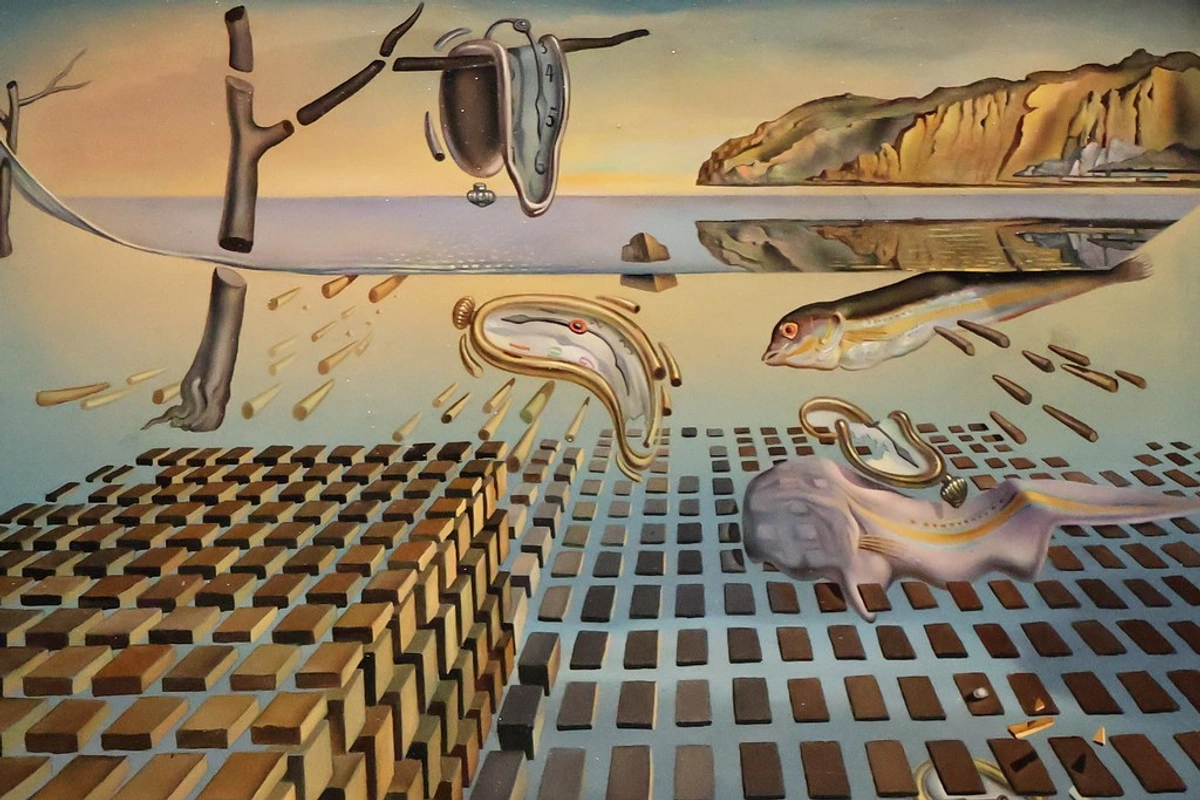

Frequently Asked Questions about The Persistence of Memory
What inspired Salvador Dalí to paint "The Persistence of Memory"?
Dalí famously stated that he was inspired by the sight of a melting Camembert cheese on a hot August evening after dinner. This mundane observation, combined with a migraine and reflections on the fluidity of time, led him to visualize the soft, drooping pocket watches that define the painting. It exemplifies his ability to derive profound symbolic meaning from everyday experiences, transforming them into a powerful artistic vision rooted in the subconscious.

What do the melting clocks in "The Persistence of Memory" symbolize? (Dalí melting clocks meaning)
The melting clocks primarily symbolize the fluidity and relativity of time. They suggest that time is not a rigid, linear progression but a subjective experience that can warp and dissolve, particularly within the dream state or the subconscious mind. Dalí's deliberate choice of portable pocket watches, rather than larger timepieces, further emphasizes a personal, intimate relationship with time, making its distortion even more poignant. They also touch upon themes of decay, memory, and the impermanence of existence, reflecting early 20th-century scientific and psychological shifts in understanding time, influenced by thinkers like Einstein, Bergson, and Poincaré.
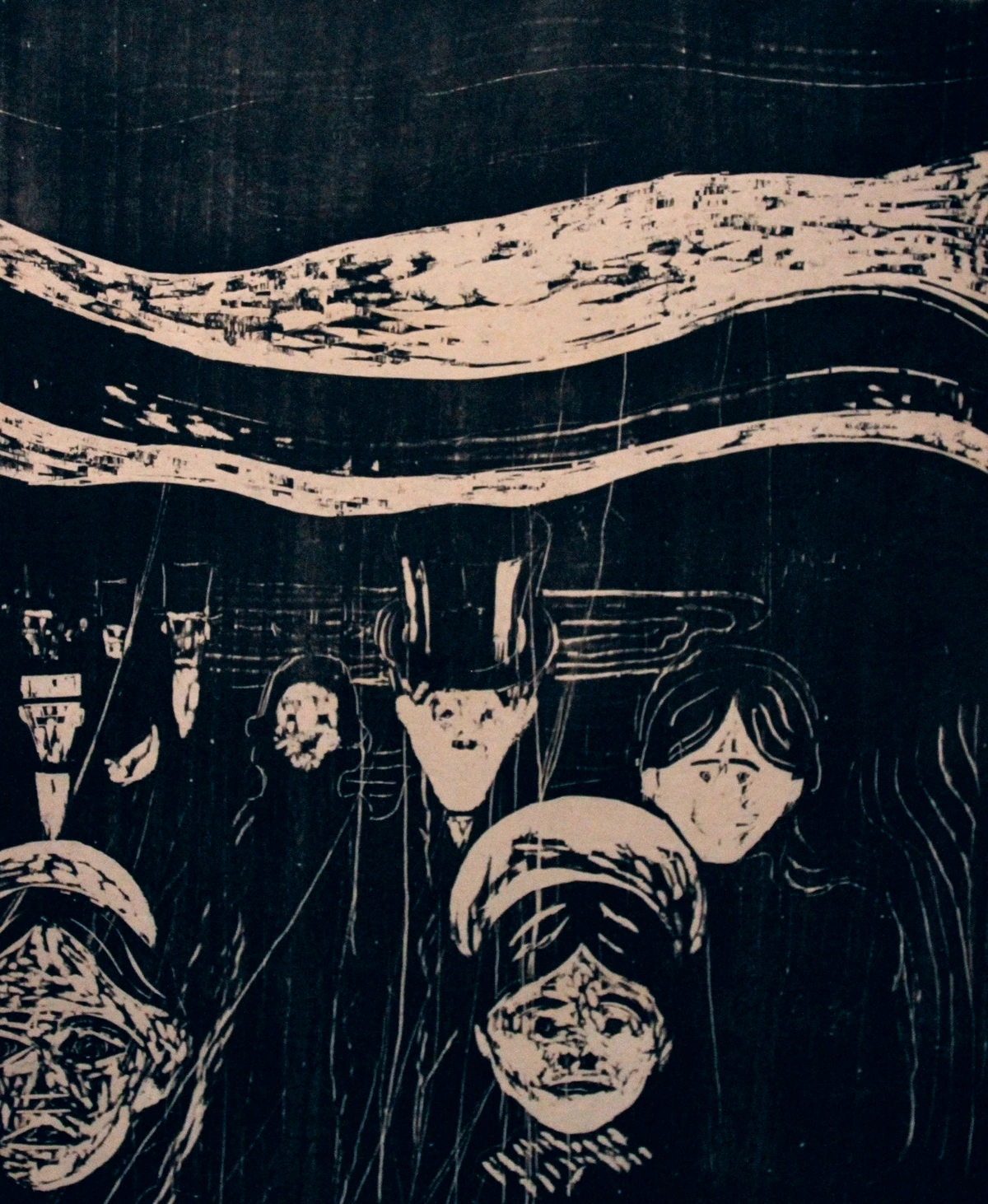
Is "The Persistence of Memory" a depiction of a dream?
While not a literal depiction of a specific dream, "The Persistence of Memory" is profoundly inspired by and visually embodies the characteristics of a dream state. Dalí used his Paranoiac-Critical Method to access and render the illogical, symbolic language of the subconscious, making the painting feel like a "hand-painted dream photograph." It invites viewers to experience the world through the logic of a dream, where conventional reality is suspended and inner truths are revealed, much like the way emotions are heightened in Munch's expressionist works. The painting embodies the surrealists' belief that dreams offer a key to a deeper reality.
What is the creature in the center of the painting? (Dalí self-portrait in Persistence of Memory)
The amorphous, fleshy creature in the center of "The Persistence of Memory" is widely interpreted as a distorted self-portrait of Salvador Dalí in a state of sleep or unconsciousness. Its vulnerable, almost fetal appearance highlights the defenselessness of the mind when it enters the dream realm, where subconscious thoughts and anxieties are freely expressed, stripped of rational defense. While the self-portrait interpretation is dominant, some scholars suggest it could also represent a universal, vulnerable human form, a primordial being, or even a symbolic creature born from the subconscious, reflecting the abstract creative process itself, or even a state of metamorphosis or transition, linking it to Dalí's interest in the fluidity of identity.
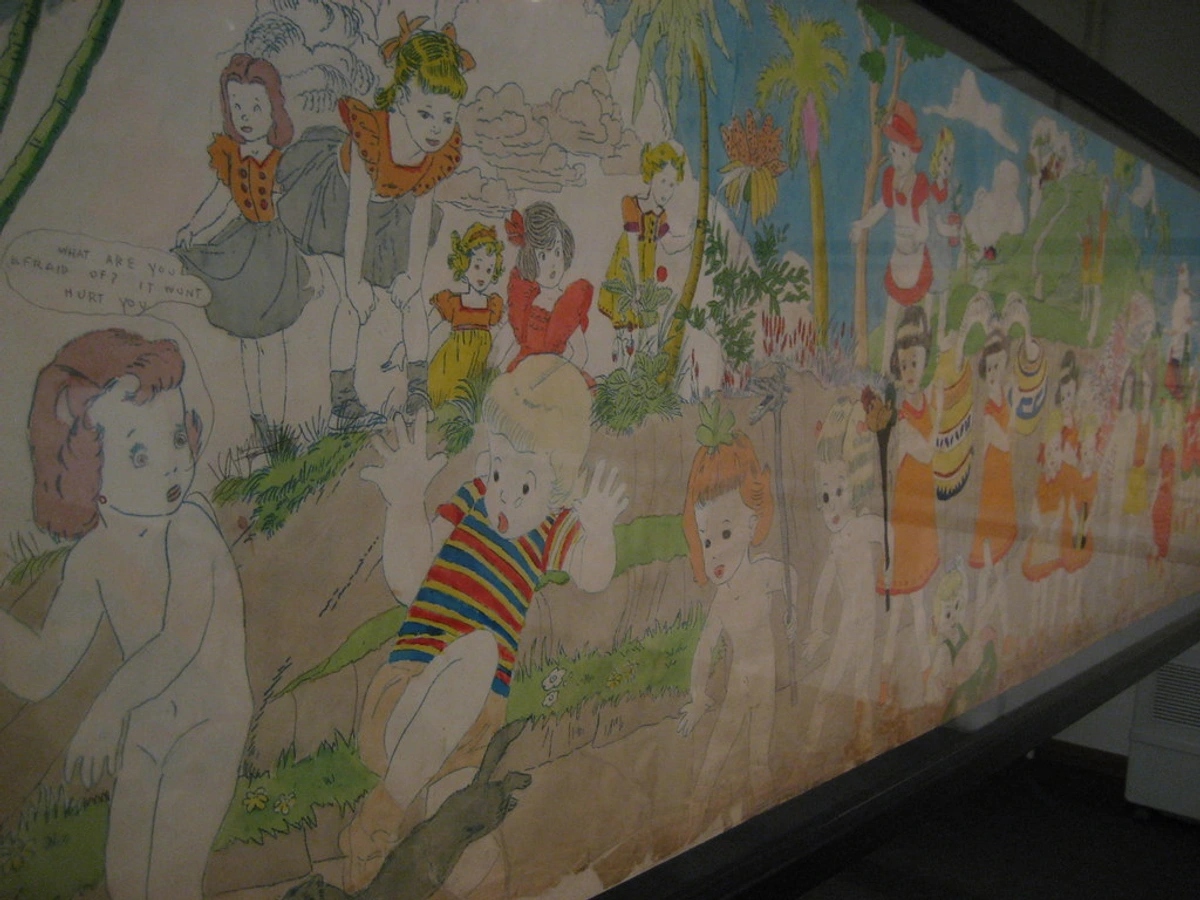
Why are there ants on one of the clocks? (what does ants symbolize in Dalí's art)
For Salvador Dalí, ants were powerful symbols of decay, death, and putrefaction, stemming from his deep-seated childhood phobias. Their presence on the hard, intact clock face emphasizes the themes of mortality, the fleeting nature of time, and the inevitable process of decomposition, adding a macabre contrast to the otherwise serene yet unsettling landscape. It represents the relentless natural forces that consume even the most rigid structures. This visceral symbol connects to Dalí's broader artistic language of primal fears and disintegration.
What are the dimensions of "The Persistence of Memory"?
"The Persistence of Memory" is a relatively small painting, measuring 9.5 by 13 inches (24.1 cm × 33 cm). Its intimate scale enhances its jewel-like quality and draws viewers closer to its intricate details, intensifying the psychological impact of its dreamlike world. This deliberate choice of scale invites a more personal and concentrated engagement with its complex symbolism.
Who is the artist of "The Persistence of Memory"?
The artist of "The Persistence of Memory" is the renowned Spanish Surrealist painter Salvador Dalí (1904–1989), one of the most iconic and influential figures of 20th-century art.

What art movement does "The Persistence of Memory" belong to?
"The Persistence of Memory" is a quintessential work of Surrealism, an avant-garde art movement that emerged in the 1920s. Surrealism sought to liberate the creative potential of the unconscious mind, often through dream imagery, automatic writing, and the juxtaposition of incongruous elements, a philosophy perfectly embodied in Dalí's masterpiece.
Does "The Persistence of Memory" carry political or social commentary?
While Dalí often claimed his work was apolitical, "The Persistence of Memory" was created in the fraught interwar period, an era marked by profound societal anxieties and questioning of established orders. The painting's themes of decay, the transience of time, and the dissolution of conventional reality can certainly be interpreted as reflecting the underlying unease of the period, even if not an explicit political statement. Its symbolic landscape can be seen as a commentary on the loss of traditional values and the rise of modern anxieties.
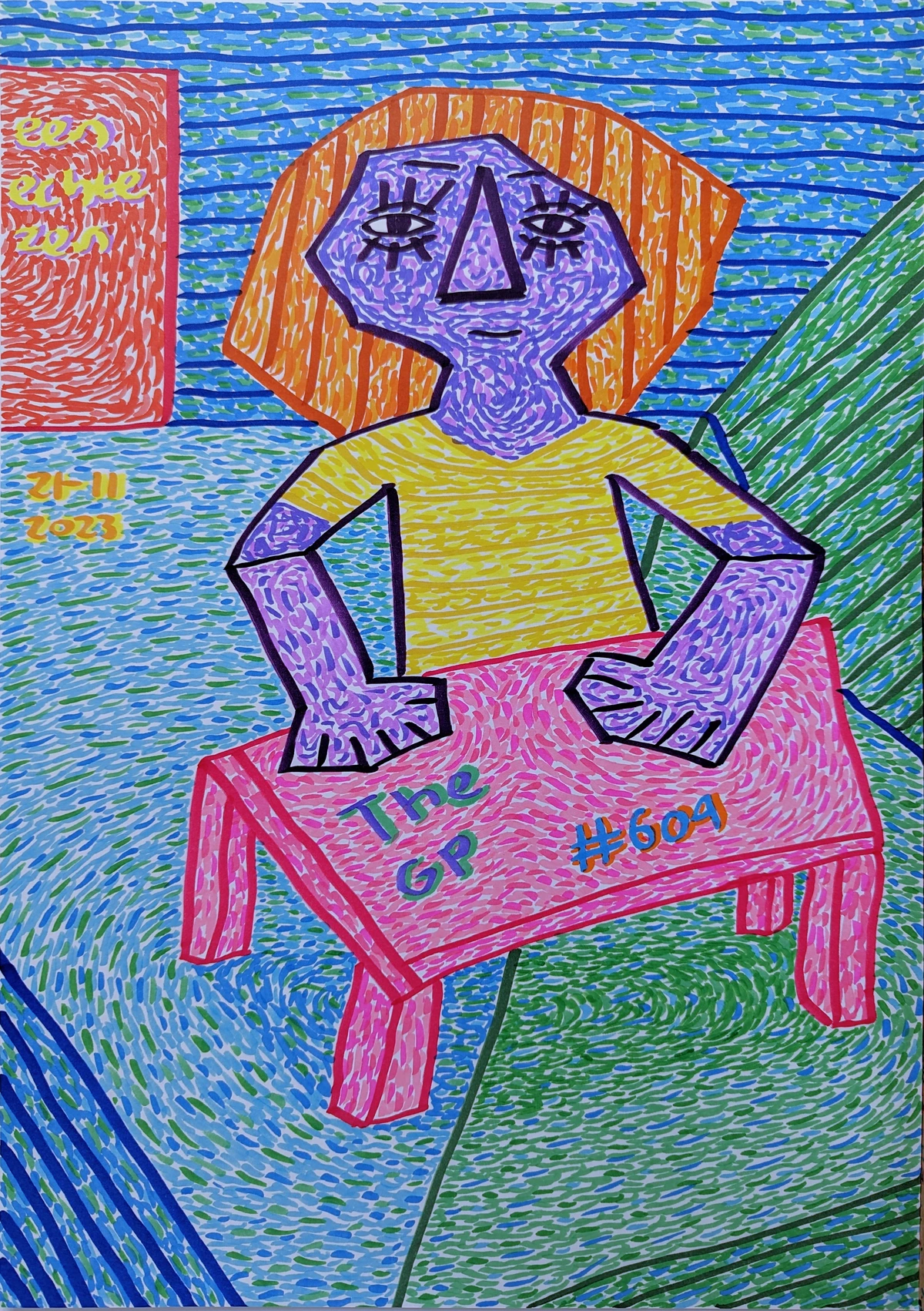
What is the overall message or meaning of the painting?
Characteristic of Surrealism, the painting does not have a single, definitive "message." Instead, it broadly explores the subjectivity of time, the power of the subconscious mind, the fragility of reality, and themes of memory and mortality. It invites viewers to confront their own perceptions of time and reality, often evoking a sense of anxiety, wonder, and philosophical contemplation. It is a visual meditation on the impermanence of existence and the dreamlike nature of human experience, a testament to Dalí's genius in making the irrational concrete.
When was "The Persistence of Memory" painted and where is it located?
Salvador Dalí painted "The Persistence of Memory" in 1931. It has been part of the collection of the Museum of Modern Art (MoMA) in New York City since 1934, where it remains a central and highly celebrated exhibit, drawing millions of visitors annually.
Conclusion
"The Persistence of Memory" remains an indelible image in the collective consciousness, a testament to Salvador Dalí's profound ability to manifest the invisible landscape of the human mind onto canvas. Its enduring power lies in its capacity to provoke introspection, challenging perceptions of time, reality, and memory. This masterpiece invites continuous dialogue, affirming art's role as a mirror to our deepest thoughts and a window into the boundless possibilities of imagination. This article aimed to provide a definitive curatorial exploration of its subconscious depths, solidifying its place as a timeless work that continues to resonate deeply with audiences worldwide, firmly establishing its place as one of the most important artworks in history. Ultimately, this painting is not just an artwork; it is an invitation to question, to feel, and to perhaps, just for a moment, to consider how one's own sense of time might stretch or dissolve, offering a profound insight into the human condition and the ceaseless flow of existence. Whether viewed as a Freudian dreamscape, a philosophical inquiry into time, or a meticulously crafted surreal vision, the painting's ability to unsettle and inspire ensures its ongoing relevance in the grand narrative of art, echoing how contemporary expressions, such as those of Zen Dageraad Visser, similarly invite viewers to explore subjective interpretations and emotional depth.




